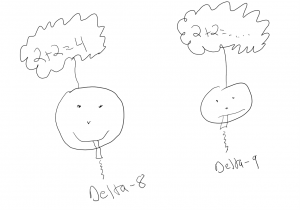 Legalizing marijuana has been a pressing debate throughout the past decade. Our generation has been able to be front and center on this hot topic. Slowly, we are witnessing states legalize it both medically and recreationally. The legalization allows for many benefits along with consequences. In a recent class discussion, we were able to discuss the endocannabinoid system (ECS) and the possibility of using marijuana-based products to activate this system. Activation of ECS is useful because the system “plays key modulatory roles during synaptic plasticity and homeostatic processes in the brain.”
Legalizing marijuana has been a pressing debate throughout the past decade. Our generation has been able to be front and center on this hot topic. Slowly, we are witnessing states legalize it both medically and recreationally. The legalization allows for many benefits along with consequences. In a recent class discussion, we were able to discuss the endocannabinoid system (ECS) and the possibility of using marijuana-based products to activate this system. Activation of ECS is useful because the system “plays key modulatory roles during synaptic plasticity and homeostatic processes in the brain.”
Within the ECS, there are cannabinoid receptors. The two receptors discussed in our research article were the CB1 and CB2 receptors. Throughout the rest of the blog, I will be mainly focusing on relationships dealing with the CB1 receptor. The CB1 receptor is found in the central nervous system and provides as a binding site to a marijuana most active ingredient which is delta-9 tetrahydrocannabinol (delta-9 THC). The binding of Delta-9 THC to the CB1 receptor allows for activation of the ECS. This allows in feelings that have been described as relaxing and pain reducing. Due to these effects, therapeutic conversations have been aroused. One use of therapy that has been discussed is using marijuana derivatives as a pain killer. The thought is to be used similarly to opioids. However, just like opioids, marijuana can have negative impacts as well. Addiction can still be present but said to be at a lesser extent in marijuana than opioids. Recreational use is used in many of the same reasons that opioids are used for which is a large part of the hold up on legalization. Delta-9 THC also provides users with paranoia and euphoria. This gives them anxious feelings along with sickness and not being able to function. Research continues to create products that will not being on these consequential feelings yet provide the consumer with beneficial effects.
Barstool Sports is a multi-media sports company and provides a podcast. On their podcast they heavily advertise for a different derivative of cannabis. They advertise 3-chi which is a delta-8 THC company. After discussing delta-9 THC in class I wanted to do more research on delta-8 THC and see what the differences are. On their website, 3-chi has a biochemist explain why the use of delta-8 THC is much more beneficial than delta-9 THC. Although this podcast and company advertises on the recreational side of things, relating this to potential medical use is relevant.
Delta-8 THC is also an ingredient in a cannabis plant but comes off as the least abundant. Through chemical reactions, scientist can make delta-8 THC out of delta-9 THC. The reaction process is what turns some researchers away due to safety concerns. When researchers get past the point of the chemical process of the THC derivative, they noticed that delta-8 does not bind as well to the CB1 receptor as the delta-9 receptor. The slight difference in the double bond as you can see below is the reason the binding is not as strong. The lower binding ability is what makes delta-8 THC a more effective product. When the CB1 does not get the perfect binding, activation is not as strong within the ECS. This has proven to provide similar benefits to delta-9 THC such as relaxation and pain reducer but does not give off the negative effects. Delta-8 users report that they do not need to use as much, and they don’t get the paranoia or the euphoria.

Whether or not recreational use of marijuana becomes legal, there is still a lot of research to be done with cannabis. Research has shown that the use of marijuana can provide medical benefits, but negative effects can come with it. The ability to derive delta-9 THC to delta-8 THC can be very significant if in further research does show the medical benefits. There is still a long ways to go, but it makes me more comfortable knowing that certain derivatives could possibly provide medical use without the negative impacts.
